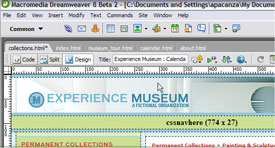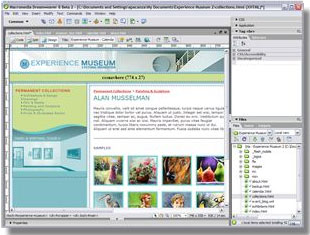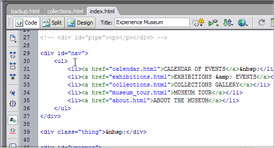 Macromedia
Dreamweaver 8 – Warp Speed Web Development
Macromedia
Dreamweaver 8 – Warp Speed Web Development
By Jim Bray
Macromedia’s Dreamweaver Web development application has
traditionally been a wonderful source of power and flexibility,
but Version 8 is by far the best yet – and addresses some
of the bloat that had been creeping into the product over the years.
Dreamweaver, and the now dead Hot Metal Pro, have been my favorite
web development apps for years, but the last version of Dreamweaver
I tried (MX) was extremely slow – so much so that it had
become ponderous to use. It took forever to load, forever to open
files, forever to – well, it just took forever. So if I had
to choose only one upgrade, it would be to make it go faster.
Version 8 is faster, a lot faster – fast enough, in fact.
Thanks, Macromedia (now Adobe)! You made my day.
 And
of course that's only one improvement.
And
of course that's only one improvement.
Here's a quick description of some of Dreamweaver 8's newest stuff:
- One of my favorite new features is Background File Transfer,
which lets you keep working while Dreamweaver uploads (or downloads)
files to/from the server. Another nice wrinkle is that you can
now upload an individual page while it's open, right from the
work space rather than having to track it down in the file manager
first. You can also upload images to the server right from inside
the open document. This is a wonderful time saver and I use it
a lot.
- Version 8 has visual tools designed to let you integrate XML-based
data (RSS feeds, etc.) into your web pages by dragging and dropping
in Design view. In Code view, you can customize the transformation
using improved code hinting for XML and XSLT.
- A new CSS (cascading style sheet) panel that consolidates and
enhances working with your cascade of styles. It's now easier
to see how they apply to specific elements and see where they
are defined. And you can use visual aids, including tool tips
such as ID, margin and border to help streamline the design and
implementation. You can also view content the way your end users
will see it, whether in a browser, handheld device or even in
print.
- A new coding toolbar puts common operations into a "gutter
bar" beside the workspace, bringing stuff closer to hand
while you're working. I hate editing code (lazy beast that I
am), but it's a necessary evil and this toolbar does make it
easier.
- And to help keep all that code from looking too overwhelming,
you can collapse or expand blocks of code, either by selecting
it or by choosing a particular tag. This is nice feature for
coders with middle aged eyes or short attention spans!
- Improved site synchronize and check in / check out. New wrinkles
here include choices that help prevent you from overwriting files
you don't want overwritten, which is great when more than one
person is working on a site. The synchronization window now gives
you additional choices between just "put," "get" and "ignore." You
can now tell Dreamweaver to consider certain files as updated,
and it'll also sound an alarm if it isn't sure whether the remote
or local version of the file is the current one.
- New pasting options let you copy and paste from e-mails or
Word documents while retaining the source formatting; you can
also just grab the text and paste it in, applying the CSS you
already have attached to your page. Another nice time saver.
Dreamweaver 8 also ups its support for ColdFusion MX7, something
I try to stay away from 'cause I'm too lazy to learn it – but
it offers a lot of power and flexibility if you're up to the task.
There's also enhanced support for PHP pages, including server behaviors
and code hinting.
 Dreamweaver
also gets easier to use with each incarnation, and Version 8 is
no different. As with MX, you're given a choice of four working
environments, from the "classic" floating windows to "coder" or "designer" view,
the latter two of which open the entire app in one big window,
with the files on one side and workspace for individual pages on
the other. And you can customize the views. I used to prefer the
floating windows, but have to admit that the "coder" view
has won me over: it's clean and lets you work on multiple pages
(via a tabbed interface) without taking up huge expanses of your
Windows taskbar. It's also nicer for keeping track of your open
pages; you can just click through the tabs rather than poking around
icons on your taskbar.
Dreamweaver
also gets easier to use with each incarnation, and Version 8 is
no different. As with MX, you're given a choice of four working
environments, from the "classic" floating windows to "coder" or "designer" view,
the latter two of which open the entire app in one big window,
with the files on one side and workspace for individual pages on
the other. And you can customize the views. I used to prefer the
floating windows, but have to admit that the "coder" view
has won me over: it's clean and lets you work on multiple pages
(via a tabbed interface) without taking up huge expanses of your
Windows taskbar. It's also nicer for keeping track of your open
pages; you can just click through the tabs rather than poking around
icons on your taskbar.
Another thing I've always liked about Dreamweaver is its combined
view of a particular web page. You can choose from WYSIWYG (What
You See is What You Get) “Design View”, HTML “Code
View”, or a combined one that offers both in separate resizable
panes, with the window split to show the code on top and the WYSIWYG
below. The latter is my preferred view, since it gives you the
best of both worlds. I like setting up a page in design view, seeing
how it'll look as I work on the page, but there are plenty of times
when one still has to roll up one's sleeves and get down and dirty
with the html code. The combined view makes this particularly easy,
and the new coding options make this even less tedious once you
get onto them – which doesn't take long.
Dreamweaver also gives you the opportunity to clean up code from
other applications. For example, it'll strip that html crap out
of a Microsoft Word document, stuff that takes forever to do by
hand. It isn’t perfect, but it's very good.
Naturally, many of Dreamweaver's old standby features are still
around, too, including but not limited to:
- When you want to put a graphic into a page and that graphic
doesn’t exist yet (or you haven't tracked it down), you
can merely put a placeholder in the html document, launch your
graphics editing application to create it (or go surfing to find
it) and, when you’re done, the graphic will automatically
appear in the html page.
- If you need to edit a graphic, you can launch the appropriate
app right from inside Dreamweaver (either by double clicking
or right clicking on the graphic), and whey you’re finished
you can click a button to update the page with the edited graphic.
- Site-wide link checking or changing. I've had trouble using
the site-wide aspects in the past (for example to search and
replace text) because once you've started it there's no going
back and this has given me fits before. But either Dreamweaver
or I have gotten a lot better at this now, and I think it's the
latter 'cause I haven't changed my methodology.
You also get a series of templates, including ones for basic and
dynamic pages, and you can also kick off the creation of your new,
dynamic site quickly with a setup wizard. As with most thing, it
helps if you understand the terminology and technology, but the
help and support community here is pretty good, too.
Dreamweaver lets you create anything from a simple web page to
a powerful and sophisticated site, and it appears that its flexibility
is limited only by the user's skill – which unfortunately
means there's a lot I don't come close to exploiting.
To me, most of the really sophisticated new features are gravy
and I'll probably never do them justice. But just the fact that
it works a lot faster now (and I mean a lot!), coupled with its
tweaked coding features and wonderfully enhanced file management
makes this version of my favorite web development app a huge improvement
over the last one I tried.